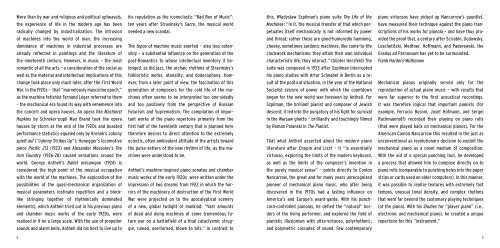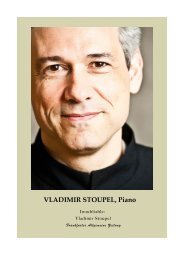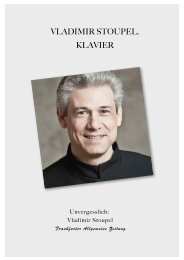the life of the machines - Vladimir Stoupel
the life of the machines - Vladimir Stoupel
the life of the machines - Vladimir Stoupel
Erfolgreiche ePaper selbst erstellen
Machen Sie aus Ihren PDF Publikationen ein blätterbares Flipbook mit unserer einzigartigen Google optimierten e-Paper Software.
More than by war and religious and political upheavals,<br />
<strong>the</strong> experience <strong>of</strong> <strong>life</strong> in <strong>the</strong> modern age has been<br />
radically changed by industrialization. The intrusion<br />
<strong>of</strong> <strong>machines</strong> into <strong>the</strong> world <strong>of</strong> man, <strong>the</strong> increasing<br />
dominance <strong>of</strong> <strong>machines</strong> in industrial processes are<br />
already reflected in paintings and <strong>the</strong> literature <strong>of</strong><br />
<strong>the</strong> nineteenth century. However, in music – <strong>the</strong> most<br />
romantic <strong>of</strong> all <strong>the</strong> arts – a consideration <strong>of</strong> <strong>the</strong> social as<br />
well as <strong>the</strong> material and intellectual implications <strong>of</strong> this<br />
change took place only much later, after <strong>the</strong> First World<br />
War. In <strong>the</strong> 1920s – that “marvelously masculine epoch,”<br />
as <strong>the</strong> machine fetishist Fernand Léger referred to <strong>the</strong>m<br />
– <strong>the</strong> mechanical era found its way with vehemence into<br />
<strong>the</strong> concert and opera houses. An opera like Machinist<br />
Hopkins by Schreker-pupil Max Brand took <strong>the</strong> opera<br />
houses by storm at <strong>the</strong> end <strong>of</strong> <strong>the</strong> 1920s and boasted<br />
performance statistics equaled only by Krenek’s Johnny<br />
spielt auf (“Johnny Strikes Up”); Honegger’s locomotive<br />
piece Pacific 213 (1923) and Alexander Mossolov’s The<br />
Iron Foundry (1926-28) caused sensations around <strong>the</strong><br />
world. George An<strong>the</strong>il’s Ballet mécanique (1924) is<br />
considered <strong>the</strong> high point <strong>of</strong> <strong>the</strong> musical occupation<br />
with <strong>the</strong> world <strong>of</strong> <strong>the</strong> <strong>machines</strong>. The exploration <strong>of</strong> <strong>the</strong><br />
possibilities <strong>of</strong> <strong>the</strong> quasi-mechanical organization <strong>of</strong><br />
musical parameters (ostinato repetition and a blocklike<br />
stringing toge<strong>the</strong>r <strong>of</strong> rhythmically dominated<br />
elements), which An<strong>the</strong>il tried out in his previous piano<br />
and chamber music works <strong>of</strong> <strong>the</strong> early 1920s, were<br />
realized in it on a large scale. With <strong>the</strong> use <strong>of</strong> propeller<br />
sounds and alarm bells, An<strong>the</strong>il did his best to live up to<br />
his reputation as <strong>the</strong> iconoclastic “Bad Boy <strong>of</strong> Music”:<br />
ten years after Stravinsky’s Sacre, <strong>the</strong> musical world<br />
needed a new scandal.<br />
The topos <strong>of</strong> machine music exerted – also less ostensibly<br />
– a substantial influence on <strong>the</strong> generation <strong>of</strong> <strong>the</strong><br />
post-Romantics to whose intellectual inventory it belonged,<br />
as did jazz, <strong>the</strong> archaic rhythms <strong>of</strong> Stravinsky’s<br />
folkloristic works, atonality, and dodecophony. However,<br />
from a later point <strong>of</strong> view, <strong>the</strong> fascination <strong>of</strong> this<br />
generation <strong>of</strong> composers for <strong>the</strong> cold <strong>life</strong> <strong>of</strong> <strong>the</strong> <strong>machines</strong><br />
<strong>of</strong>ten seems to be interpreted too one-sidedly<br />
and too positively from <strong>the</strong> perspective <strong>of</strong> Russian<br />
Futurism and Suprematism. The compilation <strong>of</strong> important<br />
works <strong>of</strong> <strong>the</strong> piano repertoire primarily from <strong>the</strong><br />
first half <strong>of</strong> <strong>the</strong> twentieth century that is planned here<br />
<strong>the</strong>refore desires to direct attention to <strong>the</strong> extremely<br />
eclectic, <strong>of</strong>ten ambivalent attitude <strong>of</strong> <strong>the</strong> artists toward<br />
<strong>the</strong> pulse-setters <strong>of</strong> <strong>the</strong> new rhythm <strong>of</strong> <strong>life</strong>, as <strong>the</strong> <strong>machines</strong><br />
were understood to be.<br />
An<strong>the</strong>il’s machine-inspired piano sonatas and chamber<br />
music works <strong>of</strong> <strong>the</strong> early 1920s were written under <strong>the</strong><br />
impression <strong>of</strong> two dreams from 1922 in which <strong>the</strong> horrors<br />
<strong>of</strong> <strong>the</strong> machinery <strong>of</strong> destruction <strong>of</strong> <strong>the</strong> First World<br />
War were projected on to <strong>the</strong> apocalyptical scenery<br />
<strong>of</strong> a new, global twilight <strong>of</strong> mankind: “Vast amounts<br />
<strong>of</strong> dead and dying <strong>machines</strong> <strong>of</strong> some tremendous future<br />
war on a battlefield <strong>of</strong> a final cataclysmic struggle,<br />
ruined, overturned, blown to bits.” In contrast to<br />
this, Władysław Szpilman’s piano suite The Life <strong>of</strong> <strong>the</strong><br />
Machines: “In it, <strong>the</strong> musical transfer <strong>of</strong> that which perpetuates<br />
itself mechanically is not informed by power<br />
and threat; ra<strong>the</strong>r <strong>the</strong>se are good-humoredly humming,<br />
cheeky, sometimes sardonic <strong>machines</strong>, like come-to-<strong>life</strong><br />
clockwork mechanisms: <strong>the</strong>y attain <strong>the</strong>ir own individual<br />
characteristic <strong>life</strong>, <strong>the</strong>y interact.” (Günter Herzfeld) The<br />
suite was composed in 1933 after Szpilman interrupted<br />
his piano studies with Artur Schnabel in Berlin as a result<br />
<strong>of</strong> <strong>the</strong> political situation, in <strong>the</strong> year <strong>of</strong> <strong>the</strong> National<br />
Socialist seizure <strong>of</strong> power with which <strong>the</strong> countdown<br />
began for <strong>the</strong> new world war foreseen by An<strong>the</strong>il. For<br />
Szpilman, <strong>the</strong> brilliant pianist and composer <strong>of</strong> Jewish<br />
descent, it led into <strong>the</strong> purgatory <strong>of</strong> his fight for survival<br />
in <strong>the</strong> Warsaw ghetto – brilliantly and touchingly filmed<br />
by Roman Polanski in The Pianist.<br />
That what An<strong>the</strong>il asserted about <strong>the</strong> modern piano<br />
literature after Chopin and Liszt – it “is essentially<br />
virtuoso, exploring <strong>the</strong> limits <strong>of</strong> <strong>the</strong> modern keyboard,<br />
as well as <strong>the</strong> limits <strong>of</strong> <strong>the</strong> composer’s invention in<br />
<strong>the</strong> purely musical sense” – points directly to Conlon<br />
Nancarrow, <strong>the</strong> great and for many years unrecognized<br />
pioneer <strong>of</strong> mechanical piano music, who after being<br />
discovered in <strong>the</strong> 1970s had a lasting influence on<br />
America’s and Europe’s avant-garde. With his punchcard-controlled<br />
pianolas, he defied <strong>the</strong> “natural” borders<br />
<strong>of</strong> <strong>the</strong> living performer, and explored <strong>the</strong> field <strong>of</strong><br />
pianistic illusionism with ultra-virtuoso, polyrhythmic,<br />
and polymetric cascades <strong>of</strong> sound. Few contemporary<br />
piano virtuosos have picked up Nancarrow’s gauntlet,<br />
have measured <strong>the</strong>ir technique against <strong>the</strong> piano transcriptions<br />
<strong>of</strong> his works for pianola – and have thus provided<br />
<strong>the</strong> pro<strong>of</strong> that, a century after Scriabin, Godowsky,<br />
Leschetitzki, Medtner, H<strong>of</strong>fmann, and Paderewski, <strong>the</strong><br />
Gradus ad Parnassum has yet to be surmounted.<br />
Frank Harders-Wu<strong>the</strong>now<br />
Mechanical pianos originally served only for <strong>the</strong><br />
reproduction <strong>of</strong> actual piano music – with results that<br />
were far superior to <strong>the</strong> first acoustical recordings.<br />
It was <strong>the</strong>refore logical that important pianists (for<br />
example, Ferrucio Busoni, Josef H<strong>of</strong>mann, and Sergei<br />
Rachmanin<strong>of</strong>f) recorded <strong>the</strong>ir playing on piano rolls<br />
(that were played back on mechanical pianos). For <strong>the</strong><br />
American Conlon Nancarrow this resulted in <strong>the</strong> just as<br />
unconventional as revolutionary decision to exploit <strong>the</strong><br />
mechanical piano as a novel medium <strong>of</strong> composition.<br />
With <strong>the</strong> aid <strong>of</strong> a special punching tool, he developed<br />
a process that allowed him to compose directly on to<br />
piano rolls (comparable to punching holes into <strong>the</strong> paper<br />
strips or cards used on older computers). In this manner,<br />
it was possible to realize textures with extremely fast<br />
tempos, unusual tonal density, and complex rhythms<br />
that went far beyond <strong>the</strong> customary playing techniques<br />
(<strong>of</strong> <strong>the</strong> piano). With his Studies for “player piano” (i.e.,<br />
electronic and mechanical piano), he created a unique<br />
repertoire for this “instrument.”<br />
2 3





